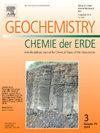Geochemical comparison of biotite from TTG batholiths and A-type complexes on either side of the Tin-Dahar fault: Geodynamic considerations (Silet region, Western Hoggar, Algeria)
IF 2.9
3区 地球科学
Q2 GEOCHEMISTRY & GEOPHYSICS
引用次数: 0
Abstract
We studied the chemical composition of primary biotite (n = 265 chemical analyses, performed by electron microprobe) from some acidic plutonic rocks in the central part of the Silet terrane (Hoggar, Algeria). Which is considered an island arc accreted onto the metacraton LATEA during the climax of the Pan-African orogeny at around 650 Ma, accompanied by northward migration of LATEA, following final clamping between the West African craton and the Saharan metacraton. The plutonic acidic rocks constitute nearly 70 % from study area, essentially represented by Tonian-Cryogenian TTG batholiths and Ediacaran-Fortunian A-type granitic complexes. They cross-cut Neoproterozoic volcano-sedimentary series and are organized into two narrow stripes with opposite isotopic signatures, separated by the N-S Tin-Dahar fault: the Juvenile Western Stripe (J-WS) and the Contaminated Eastern Stripe (C-ES). We compared biotite of the western stripe (TTG + type A granitic batholiths) with that of the same rocks of the eastern stripe (C-ES). So, we selected three TTG batholiths (Tin-Tekadiouit, Ahambatou and Silet) + two A-type granite complexes (Tin-Erit and Tioueïne) from the J-WS and one TTG type (Eheli) + two A-type granite (Teg-Orak and Inedjaren) from the C-ES. The petrographic observation shows in all studied rocks of the western stripe (J-WS) that biotite is often associated with amphibole, whereas in the eastern stripe rocks (C-ES), biotite is only. Consequently, biotite from both TTG and A-type granitoids from J-WS differ in chemical compositions from biotite from C-ES. Three biotite types were determined in the studied felsic rocks: 1- Mg-biotite in TTG batholiths of the two stripes (Tin-Tekadiouit, Ahambatou, Silet and Eheli) and in the A-type granite complex of Inedjaren, located in the C-ES; 2- Fe-biotite–annite of A-type Tioueine and Tin-Erit complexes (J-WS) and 3- Fe-biotite–siderophyllite of A-type Teg-Orak (C-ES). In detail, Mg-biotite in TTG of the J-WS reflects calc-alkaline, orogenic and peraluminous host rocks, whereas, in the Eheli TTG and the Inedjaren A-type of C-ES, it reflects calc-alkaline, orogenic host rocks. Fe-biotite–annite of the A-type granite of J-WS reflects alkali-calcic to alkaline anorogenic host rocks when Fe-biotite–siderophyllite from Teg-Orak complex, located to the north of C-ES, reflects calc-alkaline to alkali-calcic rocks.
Crystallization temperatures and pressures of Mg-biotite in TTG batholiths of J-WS are lower (750–800 °C, 3–6 kbar) than those recorded in the Eheli TTG batholith (850–900 °C, 4–8 kbar) of C-ES. Mg-biotite of the Inedjaren A-type complex (800–900 °C, 3–6 kbar) of C-ES shows higher temperature than biotite of the other A-type complexes (Fe-biotite–annite trend; Fe-biotite–siderophyllite trend), yielding variable pressure values (700–750 °C, 3–10 kbar).
The three different types of biotite are emphasized by estimates of thermodynamic conditions (T, P, fO2), which reflect the sensitivity of biotite to conditions that have controlled its crystallization and distinguish different geodynamic contexts. Our data support the subdivision of the Silet terrane (based on isotopic data) into two stripes, J-WS and C-ES, and identify two compartments within the second stripe, geographically separated by the Tahalgha Cenozoic basaltic plateau: 1- The contaminated north-east stripe (C-NES) and 2- The contaminated south-east stripe (C-SES).
Tin-Dahar断裂两侧TTG基岩和a型杂岩中黑云母的地球化学比较:地球动力学的考虑(阿尔及利亚西霍格尔Silet地区)
我们研究了来自Silet地体(阿尔及利亚Hoggar)中部一些酸性深成岩的原生黑云母的化学成分(n = 265化学分析,通过电子探针进行)。它被认为是泛非造山运动在650 Ma左右的高潮时期,随着LATEA的北移,在西非克拉通和撒哈拉克拉通之间的最终夹持,在LATEA上形成的岛弧。深成酸性岩占研究区近70%,主要为托尼—低温系TTG岩基和埃迪卡拉—福图宁系a型花岗岩杂岩。它们横切新元古代火山-沉积系,被南北向的Tin-Dahar断裂分隔成两条同位素特征相反的窄条:幼化西条(J-WS)和污染东条(C-ES)。对比了西部条纹(TTG + A型花岗质岩基)与东部条纹(C-ES)相同岩石的黑云母。因此,我们从J-WS中选择了3个TTG岩基(Tin-Tekadiouit、Ahambatou和Silet) + 2个a型花岗岩杂岩(Tin-Erit和Tioueïne),从C-ES中选择了1个TTG岩基(Eheli) + 2个a型花岗岩(Teg-Orak和Inedjaren)。岩石学观察表明,在所有研究的西部条纹岩(J-WS)中,黑云母常与角闪孔伴生,而在东部条纹岩(C-ES)中,黑云母只与角闪孔伴生。因此,J-WS中TTG和a型花岗岩中的黑云母与C-ES中的黑云母在化学成分上存在差异。研究的英质岩中确定了3种类型的黑云母:1- mg -黑云母分布在两条条纹(Tin-Tekadiouit、Ahambatou、Silet和Eheli)的TTG岩基和位于C-ES的Inedjaren a型花岗岩杂岩中;a型Tioueine和Tin-Erit配合物(J-WS)中的2- fe -黑云母-闪石和a型Teg-Orak (C-ES)中的3- fe -黑云母-闪石。在J-WS TTG中,镁黑云母反映钙碱性造山带过铝质寄主岩,而在Eheli TTG和Inedjaren a型C-ES中,镁黑云母反映钙碱性造山带寄主岩。J-WS a型花岗岩的铁-黑云母-安妮岩反射碱-钙-碱性造山带,而位于C-ES北部的Teg-Orak杂岩的铁-黑云母-铁绿橄榄岩反射钙-碱性-碱-钙质。J-WS TTG岩基中mg -黑云母的结晶温度和结晶压力(750 ~ 800℃,3 ~ 6 kbar)低于C- es Eheli TTG岩基(850 ~ 900℃,4 ~ 8 kbar)。Inedjaren a型络合物(800-900℃,3-6 kbar)的镁黑云母的C- es温度高于其他a型络合物的黑云母(铁-黑云母-斑岩趋势);铁-黑云母-铁绿橄榄石趋势),产生可变压力值(700-750°C, 3-10 kbar)。热力学条件(T, P, fO2)的估计强调了三种不同类型的黑云母,这反映了黑云母对控制其结晶的条件的敏感性,并区分了不同的地球动力学背景。我们的数据支持Silet地体(基于同位素数据)划分为J-WS和C-ES两条条带,并在第二条带中识别出两个隔室,地理上被塔哈尔哈新生代玄武岩高原分隔:1-污染东北条带(C-NES)和2-污染东南条带(C-SES)。
本文章由计算机程序翻译,如有差异,请以英文原文为准。
求助全文
约1分钟内获得全文
求助全文
来源期刊

Chemie Der Erde-Geochemistry
地学-地球化学与地球物理
CiteScore
7.10
自引率
0.00%
发文量
40
审稿时长
3.0 months
期刊介绍:
GEOCHEMISTRY was founded as Chemie der Erde 1914 in Jena, and, hence, is one of the oldest journals for geochemistry-related topics.
GEOCHEMISTRY (formerly Chemie der Erde / Geochemistry) publishes original research papers, short communications, reviews of selected topics, and high-class invited review articles addressed at broad geosciences audience. Publications dealing with interdisciplinary questions are particularly welcome. Young scientists are especially encouraged to submit their work. Contributions will be published exclusively in English. The journal, through very personalized consultation and its worldwide distribution, offers entry into the world of international scientific communication, and promotes interdisciplinary discussion on chemical problems in a broad spectrum of geosciences.
The following topics are covered by the expertise of the members of the editorial board (see below):
-cosmochemistry, meteoritics-
igneous, metamorphic, and sedimentary petrology-
volcanology-
low & high temperature geochemistry-
experimental - theoretical - field related studies-
mineralogy - crystallography-
environmental geosciences-
archaeometry
 求助内容:
求助内容: 应助结果提醒方式:
应助结果提醒方式:


